The most recent data from the USDA shows that U.S. cropland planted to cover crops increased 17% to nearly 18 million acres from 2017-22. The fastest growth is happening in the eastern and southern parts of the country, but many northern and western areas are also seeing broader adoption.
According to an Ag Equipment Intelligence report published in August 2022, no-till farmers are 2-3 times more likely to use cover crops. “When you look across the country, no-till is definitely where you see the most acceptance of cover crops,” says Jim Hoorman of Hoorman Soil Health Services in Jenera, Ohio.
Cover crops are catching on with other segments of the farming community, as well. Organic farming relies heavily on covers. More strip-till farmers are also starting to use them, as are conventional growers. According to Hoorman, government incentives are helping to drive more widespread adoption.
“Here in Ohio, we’re in the Western Lake Erie Basin,” Hoorman says. “They have a program where they are paying farmers to plant overwintering cover crops. This has led to an increase in the amount of acreage incorporating cover crops.”
In addition to being a soil health consultant, Hoorman is also a sales rep for Bird Agronomics cover crops, as well as a nationwide dealer for I&J Mfg. roller crimpers. While government incentives have definitely encouraged additional cover crop use, Hoorman believes the biggest influence has been a cover crop’s ability to solve some of a grower’s biggest headaches.
“More growers are telling me that once they begin using cover crops, there’s no going back,” Hoorman says.
Helping Growers Maximize Value
Even though the use of cover crops is on the rise, it’s important to note that we’re still only talking about less than 5% of total U.S. cropland. One of the challenges to broader adoption is that some additional upfront investment is required in the form of cover crop seed, and perhaps even some specialized equipment. At the same time, many of the benefits of cover cropping may not materialize for several years.
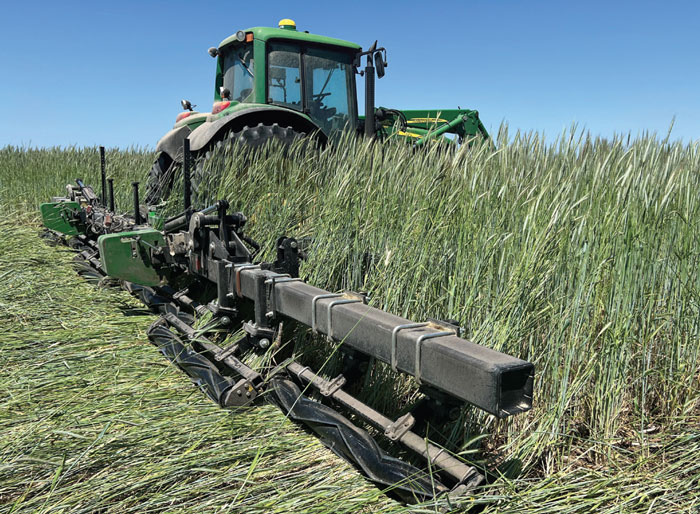
Roller crimpers are an increasingly popular way to mechanically terminate cover crops without the need for chemicals. Pictured here is some cereal rye getting rolled ahead of planting beans. Photo by: Andy Thompson, Yetter co.
According to Hoorman, it could take up to 7 years before the soil fully transitions and cover crops begin yielding a noticeable gain in cash crop yield. That’s why it’s also important for dealers to talk about the more immediate benefits of using cover crops, and how using the right equipment can help make the entire process more efficient and financially viable.
“Having the potential to reduce fertilizer inputs is a big deal,” says Doug Martin, managing member of Paul Martin & Sons, a dealership with 2 locations in Napoleon and Urbana, Ohio. Its ag equipment lines include Horsch, Hardi, Landoll, Salford, Krone, Drago, Raven, RhinoAg, Honey Bee, Nichols, Remlinger, BBI, J&M, Brillion and Demco. “Generally speaking, cover crop usage is growing as farmers look for ways to add nutrients to the soil more organically and without having to pay for so much synthetic fertilizer.”
Compaction is another concern. “Farmers in our area (northwestern Ohio) are using covers to help reduce compaction and maintain soil moisture after planting,” Martin says.
Also in northwestern Ohio, many of Hoorman’s customers are utilizing vertical tillage in a corn/soybean rotation. “Anytime you till, you form a compaction layer,” Hoorman says. “With vertical till being so shallow, the fields end up getting ponded anytime we get a half-inch of rain on 4 inches of clay. But you don’t see that ponding in the fields where farmers are doing no-till and cover crops.”
Indiana dealer Mike Hopf says erosion is the big concern in his area of southern Indiana.
“Our county has a lot of HEL (highly erodible land), so there’s already a lot of no-tilling going on,” says Hopf, owner of Hopf Equipment with locations in Huntingburg, Evansville and Jasper, Ind. “There just seems to be a lot more emphasis on trying to save the topsoil, especially during heavy rains and over the winter.” Hopf Equipment’s key ag brands include Kubota, Great Plains, Land Pride and Blue Diamond.
Takeaways
- No-till farmers are the most likely to incorporate covers, but organic farmers, strip-tillers and even conventional growers are also seeing the potential benefits.
- A variety of common and specialized equipment can help growers manage cover crops, so it’s important to determine how much a customer looking to invest and what their broader objectives are.
- Financial gain from a cash crop yield bump could take several years, so it’s important to help growers recognize the nearer-term ROI on the immediate agronomic benefits, as well as any government incentives that can help generate some additional income.
- Equipment that helps farmers reduce field passes and/or chemical use can help close the ROI gap even further.
Hopf is a believer that the ROI on cover crops starts to kick in much sooner than 7 years — especially if erosion is a recurring issue.
“Once you get that cover planted and it begins growing in November, it helps you all winter long,” Hopf says. “That’s an immediate return that multiplies each year you do it.”
Planting a Seed About Seeding Efficiency
Growers have several options for planting cover crops. For example, when seeding before harvest, growers could use specialized interseeding equipment, a drill or even an aircraft like a helicopter or drone. When seeding after harvest, they could also use a drill or aircraft, as well as an air seeder or specialized cover crop seeder. Growers could even use a traditional broadcast spreader if they wanted to leverage something already sitting in their barn.
Iowa grower Arlin Franzen utilizes a broadcast spreader to work a rye or rye/camelina mix into his corn/soybean rotation. Many of his customers at the family dealership where he also works are also having success with broadcast spreaders. But we’re not talking about any old broadcast spreader.
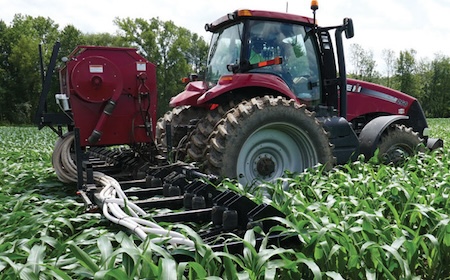
Dawn Equipment offers a range of products that fit into a cover crop operation, including the InRowL customizable cover crop roller, the ZRX and ZRX+ planter-mounted cover crop roller, the DuoSeed no-till drill (pictured) for interseeding covers into corn, and the Pluribus Strip Till Unit that’s effective at planting into cover crops. Photo by: Dawn Equipment
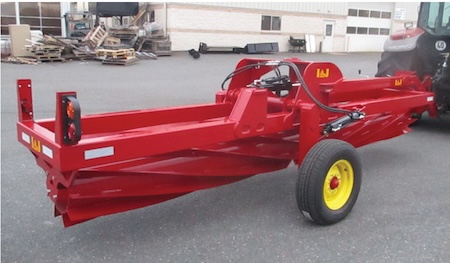
The I&J Cover-Crop Roller is a front-mounted implement that allows farmers to knock down a weed-suppressing cover-crop mat and plant through its all in one operation, cutting two no-till passes down to one. Standard roller widths are 8 feet (3-row), 10.5 feet (4-row), and 15.5 feet (6-row). Custom sizes up to 60 feet are also available. Photo by: I&J Mfg.
Franzen and his customers have taken a liking to the Kuhn Axis precision fertilizer spreader. Franzen says it is highly accurate and can be adjusted down to 50 pounds per acre. “That’s beneficial if the grower is just looking to put a light cover on the field,” says Franzen, sales manager at Franzen Sales & Service in Fort Atkinson, Iowa, whose equipment lines include Kuhn Krause, New Holland, Gehl and RhinoAg.
The bottom line is that a dealer should find out exactly what a customer is looking to do and what their objectives are, which will help determine the right spreader for their needs.
At the same time, a separate segment of Franzen’s customer base wants to seed covers while performing fall tillage. “Integrating a seeder helps ensure that the cover crop seed is properly worked into the soil, while also saving a trip across the field,” Franzen says.
Over in Ohio, Martin is experiencing the same trend. As he explains, integrating tillage and cover crop seeding helps growers drive efficiency, helping generate a nearer-term ROI.
More growers are telling me that, once they begin using cover crops, there’s no going back
“You’re talking to a customer base that is typically more conservation-minded,” Martin says. “They don’t want to be making more passes in the field than necessary. The more you can do at once, the better.”
A big seller for Martin is a Salford air seeder that can be boom-mounted or mounted to a tillage implement. He says it’s a common choice among growers who are only looking to seed cover crops and already own a reliable piece of tillage equipment. It doesn’t necessarily have to be a Salford tillage implement, either.
“We recently put one of these seeders on a Landoll tillage tool,” Martin says. “How you have to mount the seeder is dependent on the machine you’re mounting it to, so there is a bit of customization that has to happen. Otherwise, it’s just a fan through the hydraulics on the tractor.”
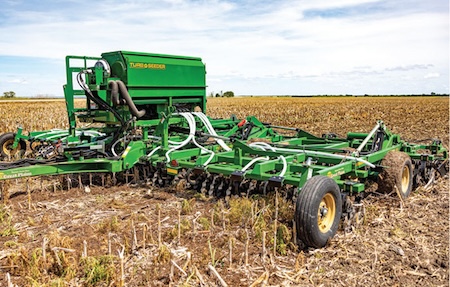
Great Plains offers a broad selection of seeding and soil management equipment suited to cover crop operations including vertical and hybrid tillage, cover crop seeders, min-till and no-till drills and planters. Pictured is their TS9100 Turbo-Seeder Attachment for installation on select Terra-Max, Turbo-Max and VT1100 Turbo-Max models. Photo by: Great Plains Mfg.
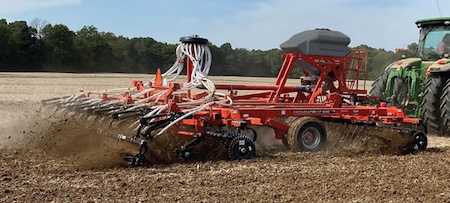
Kuhn Krause has several pieces of equipment for cover crops. Pictured is the CCX 9000 Cover Crop Seeder for use on the Excelerator XT Vertical Tillage System, which helps farmers perform two tasks at once. Additionally, the company’s Axis Spreader, while most commonly used for fertilizer, is also effective at spreading cover crop seed. Finally, Kuhn Krause’s 9400NT no-till grain drill has become popular for seeding cover crops. Photo by: Kuhn Krause
Back over in Iowa, Franzen has had success selling Kuhn Krause’s CCX 9000 Cover Crop Seeder that works with the Excelerator XT Vertical Tillage System.
“Timing is everything with cover crops,” Franzen says. “Finding the time to plant after fall harvest can be a challenge, especially with the weather and other variables often making things harder than you’d like them to be. Vertical till allows the farmer to loosen up the top layer and size up the residue. Vertical tillage implements can also cover a lot of ground pretty quickly. It really comes down to timing, efficiency and convenience.”
In Indiana, Hopf says many of his customers who’ve expanded into cover crops already had much of the necessary equipment, including old wheat drills they may have inherited. Since no-tilling is also popular, many of those growers already owned a no-till drill. And because vertical tillage is popular among the more conventional growers, Hopf says many of his customers already owned one of those implements.
One of Hopf’s big sellers is the Great Plains Turbo-Max. One of its main benefits is that it’s a multi-use tool.
“You can use it for spring tillage before planting, fall tillage after harvest, and you can also purchase a seeder for it to seed cover crops,” Hopf explains. “Operators can turn the seeder on/off from the tractor cab. This allows them to seed in selective areas, like in low spots where the water runs and they’re trying to save the topsoil. It’s a very versatile and cost-effective machine, which is important for growers who want to get into cover crops without having to invest more than they have to.”
Up in Ohio, another popular seeding option for Martin is the Horsch Avatar, which also provides the benefits of versatility and efficiency. “It can seed all types of cover crops in blends, while also being able to mix in fertilizer,” Martin says. “It can also accurately seed soybeans and wheat, giving growers some additional use out of their investment.”
Options for Killing the Cover Crop
According to Martin, cover crop termination is one of the biggest challenges a grower will face.
“To realize the full benefits of cover crops, it’s best to wait until the crop is near maturity before killing it,” Martin points out. Some cover crops will die on their own. For those that need to be terminated, some growers will harvest certain covers, while others will use them for livestock grazing. More often than not, however, growers will spray them, till them or use a specialized piece of equipment called a roller crimper to flatten them.

McFarlane has two main products for cover crops, the Incite Universal Tillage Tool and the Roller Crimper (pictured). Growers use Incite to spread cover crop seed, as well as terminate it by plowing it into the ground. The Roller Crimper attaches to the front of a tractor so it can work ahead of a planter. It also features a unique open-reel design for more effective crimping. Photo by: McFarlane Mfg. Co.
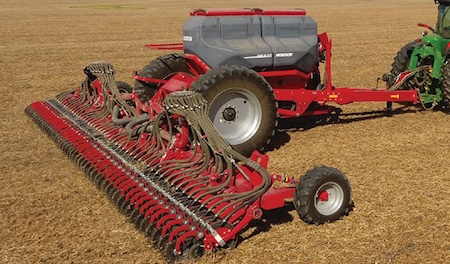
Dealer Paul Martin & Sons has seen a few of its products become especially popular with cover crop growers. Pictured here is the Horsch Avatar, an air seeder that can seed not only a variety of cover crops, but also wheat and soybeans. It also features a two-bin design and separate metering that allows fertilizer to be applied along with the seed. Photo by: Paul Martin & Sons
A roller crimper is essentially a round drum, typically with angled fins in a chevron pattern, designed to knock over tall cover, kinking the stems and damaging the vascular system so the plant dies. Roller crimper units can be added to the front of planters or the front or back of tractors.
As a nationwide dealer for I&J roller crimpers, Hoorman says increased demand has been a long time in the making. Relentless use of Roundup is tying up a lot of micronutrients like magnesium and iron, and a lot of the metabolites from Roundup can last in the soil for a couple of years.
“That’s a major contributor to why soybean yields haven’t been improving like they should,” Hoorman says. “A crimper crop roller lets the grower terminate the cover without using chemicals. That’s the big selling point, though there are many other agronomic benefits to using a crimper crop roller, too.”
“Rye is the perfect example of where a roller crimper can work really well,” Martin adds. “When those long stems are laid down, they create a mat that acts as a barrier to weed growth while also helping the soil retain moisture.”
Using cover crops is one way farmers are reducing the amount of chemicals they’re putting in the ground
Paul Martin & Sons’ big seller is the Ninja Crimper. Martin knows the product like the back of his hand. That’s because he and his business partner, Ted Stover, invented and built it before selling the rights to Remlinger in late 2022.
Martin says the roller crimper is still a relatively new piece of equipment to many growers, even though they’ve been around for many years. However, recent trends are creating an ideal environment for increased interest in this type of equipment.
“More consumers are interested in organic-based foods,” Martin says. “It seems like the overall trend is toward less chemical use, and more toward other means of weed control and cover crop termination. So roller crimpers have their place now, and that place will continue to expand into the future.”
With respect to farmers, however, the prospect of spending less money on chemicals provides the majority of the motivation for investing in a roller crimper.
“Say you have 1,000 acres and a 30-foot roller crimper,” Hoorman says. “The crimper might cost around $36,000. If the farmer has been spending $35 per acre on chemicals, they’ll pay for that crimper in a season. Additionally, a farmer can operate a roller crimper at 8-10 mph. So, a 30-foot roller crimper can cover 30 acres in an hour, which is a major time savings.”

PH Outdoors says its no-till drills are used by farmers to plant a variety of cover crops, including seed blends, for everything from cereal rye and winter wheat to sorghum, buckwheat and sunn hemp. The company’s Crimper (pictured) is offered in 6-, 8- and 10-foot working widths.Photo by: PH Outdoors

Salford’s diverse range of equipment for cover crops includes the dedicated 56 Series Cover Crop Seeders that can be attached to virtually any other cropping implement, allowing growers to seed covers without making another pass. The 5056N (N for narrow) pictured here is designed specifically for Salford’s HALO narrow folding high-speed disc. The narrow hopper also allows it to fit on other folding implements, as well, or to be paired with machines that don’t have space for Salford’s standard 56 Series seeders. Photo by: Salford Group
There is one other factor to consider in a roller crimper’s ROI analysis. When the cover crop is terminated after planting, especially when the cash crop has had a chance to grow, Hoorman says growers will often see increased yields.
“With soybeans, it’s ideal to wait until the first, second or even third trifoliate emerges,” Hoorman explains. “Some of my customers are crimping all the way to 4 or 5 inches tall on beans. They’ll end up getting an extra 5 to 7 bushel. When you crimp the soybean at that stage, you sting it, but won’t kill it. That sends a hormonal message to that plant to put on more pods.”
On corn, Hoorman says his customers typically crimp at about B3 or B4. The growing point also needs to be below the ground. “That corn may lay down for a day or two, but it bounces right back up,” Hoorman says.
Whether crimping covers in soybeans, corn or any other cash crop, there’s another agronomic benefit.
“You get that cover crop on the ground,” Hoorman says. “A cover crop like cereal rye, for instance, really won’t start decomposing until it gets in touch with the soil. That’s perfect on soybeans because it’s releasing its nutrients at a time (typically August) when two-thirds of the nutrients for soybeans are taken up. It’s like a natural slow-release fertilizer.”
Hoorman says a roller crimper can efficiently terminate just about any cover crop. That said, there are a few exceptions.
“Crimping doesn’t work on red clover, white clover, alfalfa and annual ryegrass,” Hoorman points out. The flexibility and/or lack of a stem makes these covers difficult to bend and crimp. In those instances, spraying is likely the most efficient option for terminating.

Yetter’s 5500 Cover Crop Devastator allows growers to knock down cover crops while they plant. The Devastator rolls and crimps in the direction of planting. Spring-loaded, adjustable down pressure and solid-steel construction ensure consistency and reliability. Photo by: Yetter Co.
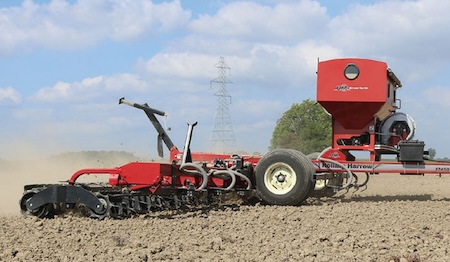
Unverferth’s Cover Crop Seeder for its Rolling Harrow Soil Conditioner allows one-pass seeding, tilling and incorporating. The hopper features a 32.5-bushel capacity, side-mounted sight windows, and a standard rollover tarp with ground operation for protecting the hopper’s contents. Photo by: Unverferth
Over in Iowa, Franzen says chemical termination is still the most common method for terminating. Growers are familiar with it and are confident it will work. Even though chemicals are being used, Franzen says many growers may still find themselves saving money.
“When you spray a cover crop to terminate it, you still get a nice mat that gives you better weed control,” Franzen says. “That means you can probably end up using less chemical to control weeds. The way I look at it is, a cover crop allows you to grow a cash crop without spending as much money on it.”
Cereal rye is a common cover crop in Franzen’s area of Iowa. At roughly $15 per acre for the seed, Franzen says it’s a good investment. If the weed control benefit can help the grower save one sprayer pass that season, the grower will likely come out money-ahead. Then, once the grower factors in some of the other agronomic benefits of using cover crops, Franzen says it becomes fairly easy to see the value.
“Using cover crops is one way farmers are reducing the amount of chemicals they’re putting in the ground,” Franzen says. “The growth in cover crops shows that farmers are really trying to grow their crops in a more efficient way.”
Dealers can have a hand in that growth by helping farmers select the most efficient cover crop equipment for their particular needs, whether that’s a specialized piece of machinery or something they’d have sitting on their farm anyway.






